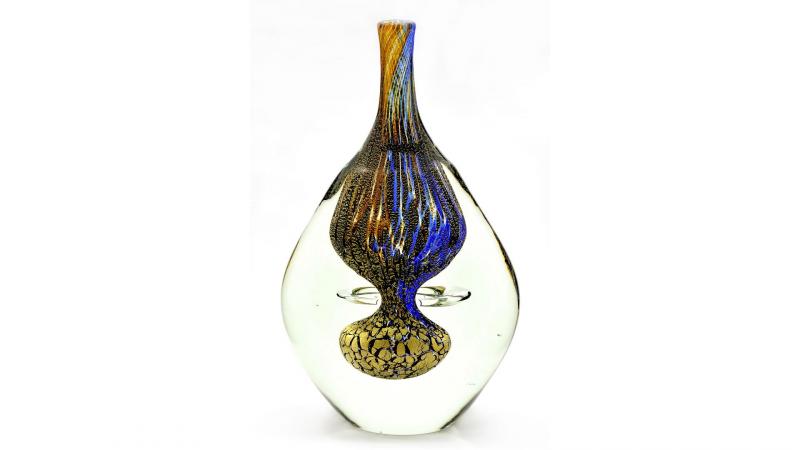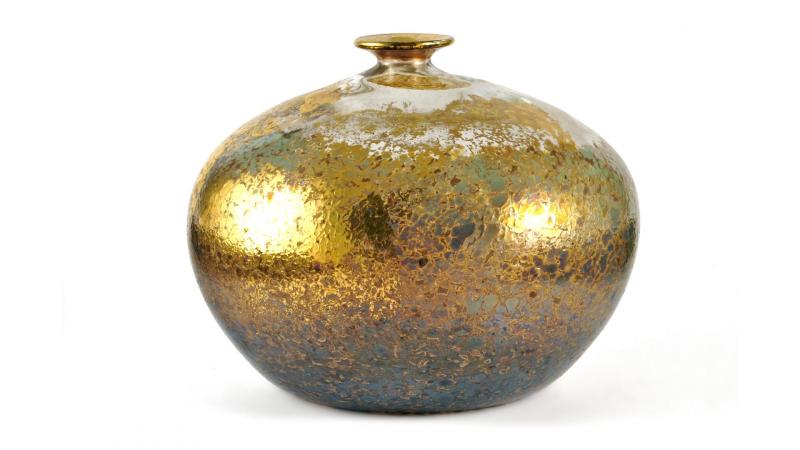The glass-blowing career of French-born Jean-Claude Novaro, who was born in Antibes in 1943, is closely linked to the glassworks of Biot, a Provençal village located between Nice and Cannes, three kilometres from the Côte d’Azur. Starting from the age of fourteen in 1957, he was involved with the glassworks, which were founded a year earlier by the ceramic engineer and master glass-blower Eloi Monod, who had trained in Sèvres. The latter preferred the production of blown glass and worked in the manner of an artisan. In order to mimic ancient glass, which contained many bubbles due to the presence of impurities in the material, he created bubbled glass, by sprinkling sodium carbonate on the glass-paste portion that the glass-maker gathered at the end of his cane. When in contact with the hot glass, the acid contained in the sodium salt releases the carbon dioxide, which causes the bubbles to form.
The young Novaro studied glasswork with Eloi Monod and, after only six years of learning, became a master glass-maker, declaring about his spiritual father: “If there had been no Monod, there would have been no Novaro”. He created his first pieces in 1967; then, wanting to perfect and discover new glass-work techniques, he left for Paris. The mature artist then returned to Biot and developed several colouring processes using metal oxides. In 1977, he moved to his own workshop near the factory. He designed original forms and, in particular, internal ornamentation, which he breathed a huge amount of imagination into using insert and inlay techniques.
Novaro used crushed glass for a large number of pieces, such as the green glass bottle and vase made in 1981; he then added other components to solidify it. The spherical mauve bottle with purple inlays contains flakes of gold-coloured metal oxides, which are placed between the coloured enamel layer and the glass layer. The neck of the vase is inlaid with dark blue and orange-brown dashes. A large inlay gives the impression of a lava flow frozen in the thick layer, creating the effect of a magnifying glass. An incomplete colourless ring surrounds the constricted portion of the inlay with veined and marbled decoration; this is obtained by inserting polychromatic oxides and gold leaves between two layers of glass. This use of metal oxides immersed in the hot glass is reminiscent of the techniques used by Maurice Marinot, who created numerous glass pieces in the 1930s.
The small bulbous vase, which was created in 1980, is one of 600 glass pieces resulting from a successful collaboration between the glass-worker and the French painter, sculptor and ceramist Jean-Paul van Lith. The glass is lighter and is decorated with sparkling ornamentation. The golden lustre covers the flared edge of the orifice and forms clouds on the upper part of the belly. The spotted pattern persists with changing colours: from sky blue to turquoise, then brown mixed with gold to dark blue and mauve when artificial light curves against the surface of the glass.
This internal decoration of shapes, which requires the mastery of sophisticated techniques developed after years of research, is the hallmark of Novaro, one of the most innovative glass-makers of the 1970s and 1980s.
Since 2011, the artist has been living in Dubai for a period of three years, in order to complete the ambitious project commissioned of him by the United Arab Emirates. This is the foundation of a glass-working school on the edge of a desert, where the sand and the heat are perfect for making glass.
Jean-Paul Philippart
Curator of the glass department
- Home
- The Museum’s collections
- Glass
- Glass with gold inlays by Jean-Claude Novaro


